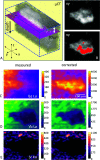Absorption Correction for 3D Elemental Distributions of Dental Composite Materials Using Laboratory Confocal Micro-X-ray Fluorescence Spectroscopy
- PMID: 38757174
- PMCID: PMC11140690
- DOI: 10.1021/acs.analchem.4c00116
Absorption Correction for 3D Elemental Distributions of Dental Composite Materials Using Laboratory Confocal Micro-X-ray Fluorescence Spectroscopy
Abstract
Confocal micro-X-ray fluorescence (micro-XRF) spectroscopy facilitates three-dimensional (3D) elemental imaging of heterogeneous samples in the micrometer range. Laboratory setups using X-ray tube excitation render the method accessible for diverse research fields but interpretation of results and quantification remain challenging. The attenuation of X-rays in composites depends on the photon energy as well as on the composition and density of the material. For confocal micro-XRF, attenuation severely impacts elemental distribution information, as the signal from deeper layers is distorted by superficial layers. Absorption correction and quantification of fluorescence measurements in heterogeneous composite samples have so far not been reported. Here, an absorption correction approach for confocal micro-XRF combining density information from microcomputed tomography (micro-CT) data with laboratory X-ray absorption spectroscopy (XAS) and synchrotron transmission measurements is presented. The energy dependency of the probing volume is considered during the correction. The methodology is demonstrated on a model composite sample consisting of a bovine tooth with a clinically used restoration material.
Conflict of interest statement
The authors declare no competing financial interest.
Figures







References
-
- Mantouvalou I.; Lange K.; Wolff T.; Grötzsch D.; Lühl L.; Haschke M.; Hahn O.; Kanngießer B. A compact 3D micro X-ray fluorescence spectrometer with X-ray tube excitation for archaeometric applications. J. Anal. At. Spectrom. 2010, 25, 554–561. 10.1039/b915912f. - DOI
-
- McIntosh K. G.; Cordes N. L.; Patterson B. M.; Havrilla G. J. Laboratory-based characterization of plutonium in soil particles using micro-XRF and 3D confocal XRF. J. Anal. At. Spectrom. 2015, 30, 1511–1517. 10.1039/C5JA00068H. - DOI
LinkOut - more resources
Full Text Sources

